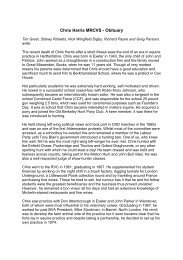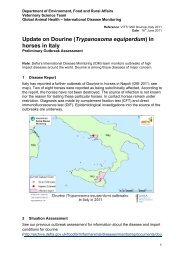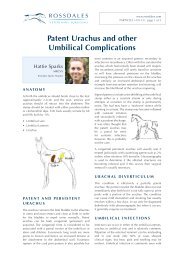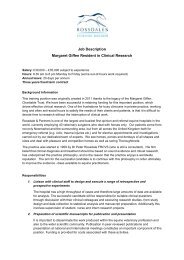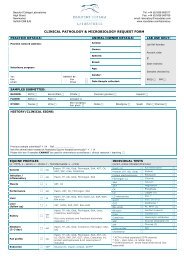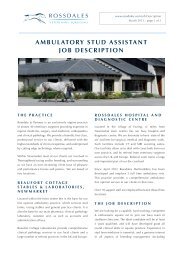EQUINE CLINICAL PATHOLOGY - Rossdale & Partners
EQUINE CLINICAL PATHOLOGY - Rossdale & Partners
EQUINE CLINICAL PATHOLOGY - Rossdale & Partners
Create successful ePaper yourself
Turn your PDF publications into a flip-book with our unique Google optimized e-Paper software.
G u i d e t o e q u i n e c l i n i c a l p a t h o l o g y<br />
Cardiac troponin (cTnI) levels are measured<br />
in serum samples (lower results may be<br />
found in plasma samples). Clinically<br />
normal horses have serum cTnI levels<br />
of less than 0.2 ng/ml. Experience so<br />
far suggests that greater than 0.3 ng/<br />
ml is abnormal, i.e. suggests myocardial<br />
pathology and 0.2-0.3 ng/ml is currently<br />
a ‘grey’ zone. Levels of 0.9-5.4 ng/ml<br />
have been measured in horses with<br />
ultrasound-confirmed cardiomyopathy.<br />
Nevertheless, results greater than 0.2 ng/<br />
ml are considered ‘red flags’ for expert<br />
cardiological appraisals.<br />
Sorbitol Dehydrogenase (SDH)<br />
This is an enzyme found in the cytoplasm<br />
of hepatocytes and is therefore virtually<br />
liver-specific, although rises are sometimes<br />
seen in horses with skin conditions and<br />
enteropathy. It is useful for the identification<br />
of acute hepatocellular damage for in-house<br />
laboratory conditions, but the enzyme is<br />
highly labile. Therefore, samples must be<br />
handled with care and assays must be<br />
performed within 8-12 hours of sampling<br />
thus SDH assays are unsatisfactory for<br />
transported samples. SDH is not assayed at<br />
our laboratories - the more stable GLDH assay<br />
is now used more frequently than SDH.<br />
Glutamate Dehydrogenase (GLDH)<br />
Elevations are seen in the presence of<br />
acute hepatocellular damage. This is a<br />
mitochondrial enzyme found mainly in<br />
liver, heart muscle and kidney. It is a<br />
relatively stable enzyme and is a suitable<br />
replacement for sorbitol dehydrogenase<br />
(SDH) (see left) in transported samples.<br />
GLDH rises are sometimes seen in horses<br />
with skin conditions and enteropathy.<br />
L-Gamma<br />
Glutamyltransferase (GGT)<br />
GGT is found in cell membranes of<br />
hepatocytes and biliary epithelial cells,<br />
but the enzyme is also found in the<br />
pancreas and kidney. Elevations in serum<br />
levels are seen in the presence of acute<br />
hepatitis, chronic liver cirrhosis and in very<br />
rare cases of pancreatitis. Nephropathy<br />
does not usually result in significantly<br />
raised serum GGT levels so high levels<br />
measured in the horse are usually a sign<br />
of biliary or cholestatic disease. Chronic<br />
pyrrolizidine alkaloid toxicity (ragwort, i.e.<br />
Senecio jacobea poisoning) causes bile<br />
duct hyperplasia and biliary stasis and<br />
therefore typically results in raised serum<br />
GGT and SAP (see below) levels. This<br />
remains an important cause of hepatopathy<br />
in horses and ponies in UK, who ingest<br />
the plant unknowingly in poor-quality hay.<br />
Toxicity is uncommon in well-managed<br />
horses.<br />
Idiopathic GGT elevations are sometimes<br />
seen in horses in training that appear<br />
otherwise healthy, but perform poorly. The<br />
cause of these GGT rises has not yet been<br />
satisfactorily defined although plant and<br />
fungal hepatotoxins have been suspected.<br />
In most cases, other liver enzymes are<br />
27



